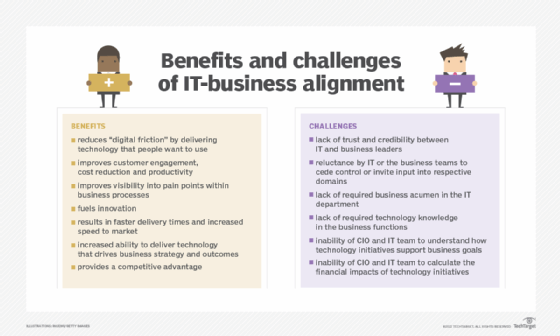What is IT-business alignment and why is it important?
It's more important than ever that IT and the business operate from the same playbook. So why do so many organizations struggle to achieve IT-business alignment?
Like many leading IT executives, RJ Juliano doesn't distinguish between technology objectives and business objectives but views them as one and the same.
"We need to be well past alignment to where the objectives are unified and indistinguishable," said Juliano, senior vice president and chief information and marketing officer at Parkway Corp., a parking garage operator and real estate developer in Philadelphia.
In Juliano's experience, a combined IT-business approach builds stronger teams and promotes meaningful dialogue as well as delivers competitive advantages and long-term sustainability of the company and brand.
"The right relationship accelerates and enables the achievement of company goals, engages customers and employees, and drives innovation in both product and process," he said, adding that separating technology from business outcomes typically does the opposite.
This article is part of
The evolving CIO role: From IT operator to business strategist
Sharon Stufflebeme, managing director in the technology consulting practice at the consultancy Protiviti, said the CIO's role today is to anticipate, influence and deliver on the company's business strategy.
 Sharon Stufflebeme
Sharon Stufflebeme
"But CIOs can't anticipate, influence or deliver on things if they don't know what those needs are," she said. For that to happen, there needs to be IT-business alignment throughout the organization.
What is IT-business alignment?
Executives, management consultants and researchers have long stressed the need for IT and the other business functions to align their priorities and strategies.
Information technology is no longer a supporting player within the enterprise but part of the main engine. Indeed, computer technology has driven business growth for decades, with the internet and digitalization transforming both how people work and how they engage with organizations and each other. That makes IT-business alignment paramount to business success.
"It's the assurance that the technology being delivered enables the business to succeed," said Rebecca Gasser, CIO of Omnicom Health Group, of the benefits of IT-business alignment. "Some of this is foundational like networks and infrastructure, but a lot of this is the technology that provides a competitive advantage to the business," she said.
 Darren Topham
Darren Topham
IT-business alignment, although widely recognized as critical today, has not been the norm within most organizations until recent years, said Darren Topham, a senior research director at Gartner, a tech research and advisory firm.
In its earliest decades, the IT department focused on delivering computing hardware, software and services as a utility. Under this paradigm, technology was a tool that aided workers in their usual tasks, with reliability and uptime being the main measures of IT's success, Topham said.
However, that paradigm evolved over the years, and in particular in the 21st century, as more technology executives teamed with their C-level and business colleagues to use technology to reengineer work, products and services.
This led to a slew of disruption, as startups introduced entirely new business models and as legacy companies transformed their own processes and market offerings.
CIOs and their IT teams must still deliver utilitarian technology services, Topham said. But they must also now have the capacity to strategize how technology can shape what the enterprise offers for products and services as well as how it delivers those offerings.
"This is where alignment is manifested," he explained. "It's where everyone from both sides is bringing something to the table for communal benefits. There's no 'them' and 'us.'"
Topham added: "The ultimate expression for this is the term digital business."
Why is IT business alignment important?
IT-business alignment ensures that the IT organization and business units are working together and moving in the same direction at the required speed.
 Rebecca Gasser
Rebecca Gasser
"Technology can be exciting, but oftentimes it is expensive and not as fit for purpose as originally hoped. By partnering and being aligned, the business and the technology team can ensure the ROI is present, it is supported and it is the right fit for the business," Gasser said.
Surveys and studies back up the importance of IT-business alignment.
According to the Gartner report "The CIO's Role in Preparing for Digital Business Acceleration," more than 70% of senior leaders "recognize digital technology as integral to revenue achievement, product development, customer engagement and advancing strategic operational processes."
In its "2021 Evolution of CIO Responsibilities Survey," Gartner noted that 83% of responding CIOs said they "increasingly work on enterprise-level initiatives beyond their traditional IT delivery executive roles."
Meanwhile, "IT's changing mandate in an age of disruption," a 2021 report from The Economist Intelligence Unit based on a survey of more than 1,000 IT decision-makers and senior business executives, found that 83% believe adapting to external change requires moderate-to-considerable IT infrastructure and apps improvement.
"IT has to serve every business function as technology has now become pervasive," said Protiviti's Stufflebeme. IT-business alignment helps ensure that the organization gets the right technology at the right time so it can meet its key performance indicators and reach its business transformation goals and objectives -- whether those are improving customer service or developing new revenue streams.
Stufflebeme said the lack of IT-business alignment creates significant barriers to market success for organizations.
"When alignment is missing, the technology might work but it might not deliver an outcome the business needs," she said. "You have solutions that end up being bridges to nowhere, you have business problems that aren't properly solved, or you have business initiatives -- whether it's a cost saving or efficiency improving [program] -- that aren't properly executed."

What are the benefits of IT-business alignment?
Experts cited the following benefits that come with having the IT department aligned with the business functions:
- It reduces digital friction because IT is able to deliver technology that is easier for workers, customers and partners to use. "This has a huge impact on an organization's achievement of objectives and productivity," Topham noted.
- Customer engagement, cost reduction and productivity improve.
- Organizations gain more visibility into pain points in both business processes and the technology that supports them.
- It fuels innovation, as teams are better able to identify problems and opportunities that can be addressed through the use of technology. "You're getting to the concept of co-creation, and that creates more value for the organization," Stufflebeme said.
- It results in faster delivery times and improves speed to market due to increased collaboration and innovation.
- It increases ability to deliver technology that drives business strategy and goals.
- It provides a competitive advantage in the marketplace.
 Jo Ann Saitta
Jo Ann Saitta
IT-business alignment allows an organization to have an edge, said Jo Ann Saitta, managing director, EY Business Transformation Consulting, Health Sciences. "It allows [the enterprise] to stay current or even ahead of the curve."
What are the challenges of IT business alignment?
Despite the criticality of having a strategic alignment between IT and the business functions, Stufflebeme said plenty of organizations still struggle to do that.
She and others cited a number of obstacles and challenges that executives and their teams face on this front, including the following:
-
lack of trust and credibility between IT and business leaders: "The biggest challenges are having a CIO who pursues and creates unity [between IT and the business] and having a corporate culture that also expects and fosters that unity," Juliano said;
 RJ Juliano
RJ Juliano
- reluctance by IT or the business to cede control or invite input into one's respective functional domains: Some CIOs still have a command-and-control approach, while some organizations still have a culture that views technology as only the realm of IT, Topham explained, adding that both mentalities need to change to achieve alignment;
- lack of business acumen within the IT department;
- lack of technology knowledge throughout the business functions;
- inability of IT to understand how technology initiatives can support business goals;
- inability of IT to communicate how technology initiatives can support business goals; and
- inability of IT to calculate the financial impacts (costs and ROIs) of technology initiatives.
IT business alignment best practices
To overcome such challenges, experts offered the following best practices:
- Create shared accountability and shared value realization between IT and the business. "This can no longer sit just on the shoulders of the CIO," Topham said, adding that CIOs should train functional executives to manage their own technology portfolio to support shared accountability.
- In addition to becoming good communicators, develop good listening skills. "It helps you understand what the current state is and what would look great in a future state," Saitta said.
- Embed technologists within the business units and have IT workers engage directly with their business unit counterparts by attending meetings and adopting Agile and DevOps practices that promote collaboration. "Then technology becomes a natural part of the business," Saitta said.
- Create incentives for employees throughout the organization to work toward IT-business unit collaboration.
Such practices, Juliano said, can eliminate any gaps between IT and its business counterparts and help the organization reach a place where the two are -- in his words -- "unified and indistinguishable."
All important goals are shared goals, he underscored, adding that the joint collaboration between IT and the business must go beyond just buy-in to common goals to include joint accountability for the results.








